Roger J. Wendell
Defending 3.8 Billion Years of Organic EvolutionSM



|
Tibet and the Dalai Lama In June, 2001, I visited Tibet, China and The Silk Road extensively. In later years I returned to China and got a close look at Hong Kong and Macau. It was clear that the Chinese government's brutality towards the people of Hong Kong, Tibet, and Xingiang was only worsening... |
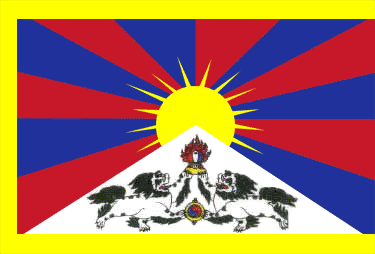
|
At various times, Tibet has been labeled "Mystical Land," "Shangrila," "Forbidden Country," and "Roof of the World." Tibet has an average elevation of about 13,000 to 16,000 feet [4,000 to 4,800 metres] (depending where you look on the Internet...) with an area of 470,000 square miles [1.2 million square kilometres] - making it 75 percent larger than Texas and a whole lot higher than my home state of Colorado! |
Why are we so afraid?
It's March 15th, 2008, and the world (and our country) has just stood by for the past few weeks watching the peoples of Tibet, Xinjiang, and Palestine being brutalized by China and Israel, respectively. Why are we so afraid to speak up? Is it because the Palestinians have no oil? Or, is it if we upset the Chinese we won't be able to buy anymore of their trinkets and other junk at Wal-Mart? I don't know what it is but the silence is deafening as these peoples continue to be forced out of their homes while their countries are taken over...
- Roger J. Wendell
March 15, 2008
Hey, I was wrong - there are some people out there with guts!! About a week after the above entry, US House speaker Nancy Pelosi angered the Chinese government by speaking out against the treatment of Tibet! And, going beyond just words, she actually went and met with the Dalai Lama (exilded in India) despite loud Chinese government protests. Pelosi said, "If freedom-loving people throughout the world do not speak out against China's oppression in Tibet, we have lost our moral authority to speak on behalf of human rights anywhere in the world." The Xinhua state news agency responded by saying Pelosi was a "defender of arsonists, looters and killers." Hmmmm, sounds like the same thing Israel says anytime somebody trys to defend the rights of Palestinians to return to their homeland!
- Roger J. Wendell
March 24, 2008
CNN/Opinion Research Corp. Poll
February 18, 2010
- Good News - According to a new national CNN poll, nearly three-quarters of all Americans think Tibet should be an independent country.
- Bad News - In that same survey, however, Americans said that it is more important to maintain good relations with China than to take a stand on Tibet.
Report: 100 dead in Tibet violence
CNN March 15, 2008
"'The victims are all innocent civilians, and they have been burnt to death,' an official with the regional government told Xinhua.""Tibetan exiles in India meanhwile cited unconfirmed reports that at least 100 people were killed and many more injured."
"Video broadcast on China's CCTV Saturday showed flames and black smoke rising the market, where hundreds of rioters used hands, feet and sledge hammers to break down doors and shatter windows."
"The protests in Tibet began Monday when hundreds of monks rallied on the 49th anniversary of a failed uprising against Beijing that forced the Dalai Lama into exile."
"Police used gunfire and tear gas to quell the Lhasa protest, according to witnesses, human rights groups and Xinhua."
"Demonstrators set fire to vehicles and shops. One source said late Friday that up to a third of the city may be on fire and that power lines had been cut."
"A main market in Lhasa, Tromsikhang Market, was set on fire, said Kate Saunders, a spokeswoman for the International Campaign for Tibet. The market has many Chinese traders, and she said Tibetans have been concerned about the influx of Chinese into the area."
"Chinese bloggers and U.S.-based human rights groups said Chinese security forces had sealed off the three main monasteries around Lhasa after the violence broke out. The bloggers also said police wearing armored vests were moving toward Lhasa in armored personnel carriers."
"Beijing is hosting the Summer Olympics in August, and Tibetan exile groups told CNN they plan to hold demonstrations when the torch is carried through India in April."
"CNN sought permission to enter Tibet on Friday, but the permission had not been granted by Friday evening Beijing time. CNN reporting on Tibet was being blacked out Friday in mainland China."
"Chinese authorities blamed the Dalai Lama for the unrest, but the Dalai Lama said the protesters were simply acting out of 'deep-rooted resentment' of the Chinese government."
"'As I have always said, unity and stability under brute force is at best a temporary solution. It is unrealistic to expect unity and stability under such a rule and would therefore not be conducive to finding a peaceful and lasting solution,' he said in a written statement."
"'I therefore appeal to the Chinese leadership to stop using force and address the long-simmering resentment of the Tibetan people through dialogue with the Tibetan people. I also urge my fellow Tibetans not to resort to violence.'"
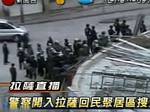 Chinese plolice search Lhasa |
What the Chinese have done, and are doing, to Tibet is horrible. It sickens me to see that most of the world's concerns are with the Chinese hosting of the Olympic games - something that should never have been awarded them in the first place. Let's hope, at least, that these goofy Olympic games help raise awareness of not only what China has done to Tibet, but the horror it has brought Xinjiang as well...
Golden, Colorado - 03/15/2008 |
"Few cultures could have survived an invasion the magnitude of which Tibet experienced at the hands of the Chinese in 1959. Everything from the basic food staple, tsampa - roasted barley flour - to the current Dalai Lama was targeted in the wake of the brutal takeover. The so-called liberation left monasteries decimated and claimed over 1.5 million lives resulting in cultural genocide, according to the exiled Tibetan government based in Dharmsala, India."- David Kootnikoff
adbusters, jan/feb 2007
|
We live in illusion, the appearance of things. But there is a reality. We are that reality. When you understand this you see that you are nothing, and being nothing, you are everything. That is all. - Tibetan Buddhist teacher Kalu Rinpoche |

|
My photos from our trip in and around Lhasa: (Tibet's capital - 3,700 metres) |
(Click on any of these "thumbnail" images for a larger view) |
 Prayers |
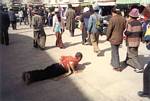 Street prayer |
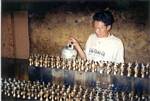 Yak Butter candles |
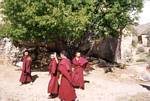 Young monks... |
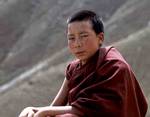 Young Tibetan in Contemplation |
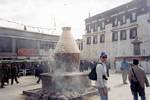 Tibetan Incense |
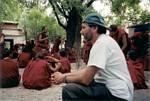 Sera Debating Courtyard |
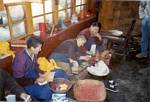 Tibetan Nunnery |
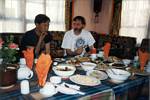 Gedhun and me |
 Yak meat |
 Me and a solar tea cookers |
 Utility Tractor |
 Tibetan Tourist Transportation |
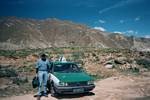 Taking a Tibetan a cab... |
 Local villagers |
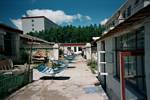 Cooking tea with solar |
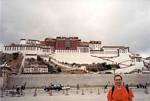 In front of the Potala Palace |
 The wrong flag!! |
 Top of Potola Palace |
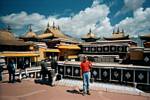 Onn top of the Potola Palace |

|
Click Here for the Government of Tibet in Exile (their official website) |

His Holiness the 14th Dalai Lama of Tibet


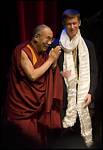 HH and Denver Mayor Hickenlooper |
|


"One is a palace whose god-king has fled. The other a temple - dark, smoky and sticky underfoot. Each visible from the roof of the other, and both located on the very roof of the world, together they form a dramatic double act of spiritual power, architectural splendor and faith enduring against all odds.""The breathtaking Potala Palace and Jokhang Temple, chosen by our panel of experts as one of the seven New Wonders of the World, pierce the heart of Tibet's capital of Lhasa. Together, they have filled visitors with awe for centuries - and still do, despite the tragedy of modern politics."
"Perched serenely on a hill above the modern clutter of an ever-more Chinese city, the red and white Potala dominates the Lhasa River valley. With 7th-century origins, the present structure was built in the 17th century by the 'Great" Fifth Dalai Lama, Tibet's spiritual and temporal ruler."
"Within its 13 stories and thousand rooms lie the remains of several Dalai Lamas and a feast of art and stauary from Lamaism, Tibet's mystical development of Indian Buddhism. It is a labyrinth of creaking staircases and dark chapels, where pilgrims place ceremonial white scarves and pour libations of yak butter or oil."
"The Potala's last resident, the 14th Dalai Lama, Tenzin Gyatso, fled Chairman Mao's troops in 1959 amid a failed uprising and has remained in exile in India ever since."

Did you know?
"Despite over 40 years of Chinese occupation of Tibet, the Tibetan people refuse to be conquered and subjugated by China. The present Chinese policy, a combination of demographic and economic manipulation, and discrimination, aims to suppress the Tibetan issue by changing the very character and the identity of Tibet and its people."
- from the Government of Tibet in Exile, fall '06

Losar Tradition
by Phurbu Thinley (with permission)
Phayul Correspondent
The Tibetan New Year is already here around the corner and it all means time to enjoy traditional feasts and guzzle down sour Tibetan beer-Chang-tasting a tinge of sweetness in it. It also means traditional group dances and overflowing sounds of songs. For Tibetans, New Year is also a time for prayers and togetherness- an occasion to keep oneself in rejoicing spirit with family members, relatives, friends and neighbors.Of the countless festivals held all over Tibet, the most important, the most popular and the much awaited of all in a year for Tibetans is their New Year Celebration. Tibetans call it LOSAR (Lo meaning, Year and, Sar means New) and is usually celebrated for three days.
Tibetans follow lunar calendar, so dates for Losar may vary every year vis-à-vis Christian calendar. This year, the New Year falls on February 18, and is the Fire Pig Year-2134.
Significance of Losar:
As Tibetans around the world gear up to celebrate their biggest celebration of the year; it is not surprising to know that Losar is the most special occasion for them to exchange warmest greetings to their fellow relatives, family members and neighbors and to everyone around.Losar, for Tibetans, means mass celebration, complete relaxation and, plenty of festivities with abundance of festive-meals and being in best dressing clothes. Offering Khatas (traditional greeting scarves) on the home altars, in monasteries and around each other with heartfelt Tashi Delek greeting all mean flourishing auspiciousness and greater prosperity.
"It is time again for prosperous Losar," Tibetans would generally exult.
It's time of the year for ultimate family gathering, lavish spending and joyous atmosphere at home. It is a valued culture for Tibetans to be kind hearted, hospitable and welcoming to guests, but it is on Losar days that these cherished values are most visible.
Tradition has it that one has to be very warm hearted, generous and welcoming during Losar celebration. A bright and jovial mood on Losar is supposedly believed to ensure that a person will be blessed with good and happy expression throughout the year.
A guest to a Tibetan family during Losar is always received with utmost hospitality. Among other things, a hearty meal and overflowing Chang will always await a guest. So do, Tibetans extend heartfelt welcome to guests during Losar.
The Build-up to the Tibetan New Year
Preparations for Losar usually start weeks before the Day and the count down for it may begin even much earlier; especially among the young ones waiting with anxious hope for New Year presents.Preparation for Losar includes people arranging religious offerings, a lot of shopping for new clothes or Losar dress-up they call it and, food and drink for the feasts.
Losar feasts include, the most popular traditional Tibetan Dish, Dresi, sweet buttered rice with raisins and dromas (small fibrous potatoes); substantial amount of meat variety, fruits, breads, chang, butter tea, among other ingredients; and Khabse, a fried sweet or salted baked snacks that comes in different shapes and forms. Tibetans are supposed to see in the Losar with Khabses piled high up on their tray.
In monasteries and at homes, religious altars are decked up with special New Year adornments of thankas, scarves and, finest edible and related traditional offerings.
Besides, Tibetans observe the following two significantly important occasions marking the final build-up for the Losar celebration.
Gutor-The day before Losar Eve (29th Day of the 12th Lunar Calendar)
To Tibetans, the year's end is also of special importance and Tibetans observe Gutor while they are just two days away and busy preparing for the New Year's Day.Gutor is the day before New Year Eve and Tibetans come together on this day to enjoy themselves. Filled with the atmosphere of the year's end, Tibetan families eat Guthuk, gruel-soup with dumplings, in the evening on Gutor.
"Traditionally, Tibetans say that Gutor is the only day when all Tibetans, including His Holiness the Dalai Lama, eat the same food."
The dumplings contain symbolic items or revelations wrapped inside them that might give possible indication of fortune or nature of a person whoever gets it. On opening the dumpling, one will find an "Oracle": a thread is for longevity, white wool indicates a Pure Heart, a charcoal for Black Heart, a chili might mean foul or sharp tongue etc. For a large Guthuk gathering, written note is more preferable.
While soup is being served, everyone delights in showing off their "Oracle" to one another that will definitely draw in lots of funny comments- a good way to usher in for the year's end in hearty laughter.
Following this, everyone participates in a religious ceremony to exorcise evil spirits from the previous year, which is the original purpose of the Gutor. Everyone puts some left over gruel soup and a fisted-dough containing a piece of clothes from one's clothes over a doll representing a fierce god. The godly effigy is then set-off with fireworks or firecrackers at a distant road junction. Doing these symbolise driving away of personal obstacles, and is believed to keep you untouched by sickness and misfortunes all through the year.
Namkhan- New Year Eve (30th Day of the 12th Lunar month)
New Year's eve itself is for cleansing houses, giving final concluding touches to the house decoration and altar offerings and, quiet relaxation and wait in anticipation for the following day's ultimate festivities.So, Namkhang puts one whole year behind. Just hours away from ushering into a new year, Tibetans look forward to Losar as a harbinger of greater prosperity and auspiciousness to start another new year all over again in a brand new way.
LOSAR (1st to 3rd day of the first lunar month)
With mellow smell of traditional snack-KHABSE and sweet sour odour of Chang overflowing in the air; Losar begins by tossing chang and Chemar offerings and exchanging greetings by saying Tashi Delek (meaning-Prosperity, Sound Health and Goodness!) to family members and neighbours.On New Year's Day even young Tibetans wear Chuba (traditional Tibetan attire) and pay their first visit of the year to a temple with their family early in the morning. After that, Tibetans do nothing but feast on the food and drinks that they have so painstakingly prepared. The New Year's Day is for family celebration and everyone spends time with family or the neighbours.
From the second day onwards, they then visit their relatives and family friends. They visit each other's feats and have parties full of drinking and singings and dances. On Losar days, Tibetans don't miss an opportunity to enjoy gambling, with games of Sho (Dice), or, Pakchen (Mah-jongg). In recent times, many have fallen to playing-cards too. For young Tibetans, Losar is the time to thicken their pockets with lots of gift money.
On the third day, as the festivity continues, Tibetans replace the year-old Dhar-choks and Dhar-shings (hoisting of prayer flags) on the roof of their houses with new ones and burn thick bunches of Sang (Incenses). Upon hoisting, barley flour is tossed into the air screaming Kyi-kyi So-So Lha Gyalo!!! (Happiness, Happiness and let Victory be to God).
New Year Prayer Festivals (4th to 15th of the first Lunar month)
In a follow up to the Losar, from 4th to 11th day of the 1st Lunar month, a great Buddhist service Monlam (Prayer Festival) is held and Cham (Buddhist dances) are performed at monasteries. The largest of such prayer festival used to be held in Jokhang Temple in Lhasa, Tibet's capital city, where most monks from the monasteries around Lhasa would gather and hold Monlam Chenmo or Great Prayer Festival.The 15th day or the full moon day of the first Lunar month, Choenga Choepa, also called 'Butter Lamb Festival' is held, which becomes the highlight of the Monlam.
Perhaps because the prayer festival too strongly encourages Tibetan identity, the Communist China banned it during the Cultural Revolution and although it was revived later, it was prohibited again in 1990.
Similar events, which used to be part of the prayer festival held in Lhasa are now carried out in the northern Indian town of Dharamsala where the Dalai Lama led Tibetan Government in Exile is now located.
From New Year's Day until the end of Monlam, Tibetans continue to eat, drink and make merry.
Popularly, Losar is celebrated in the first Lunar month, but this may not be the same all over Tibet. A large section of Tibetans even celebrate Losar a month earlier in the beginning of the 12th month. In both the case, after so much feasting, it is no wonder that the festive mood may sometimes linger on for days even after the initial three days of celebration with lots of lingkhas (public picnics) in Tibet. But things have changed over the years.

More Tibet Stuff:
Links:
|
|

 Back to Roger J. Wendell's Home Page...
Back to Roger J. Wendell's Home Page...
Abbey |
About |
Blog |
Contacting
Me |
Copyright |
Disclaimer |
Donate |
Guest
Book |
Home |
Links |
Site
Index |
Solutions |
Terms,
Conditions
and
Fair
Use |
What's
Changed
or
New?
Copyright
© 1955 -